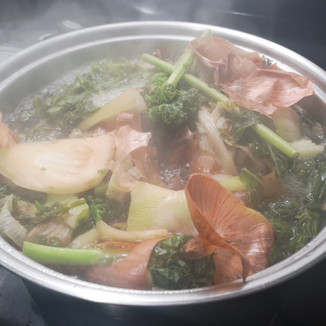
What is the difference between stock and broth?
The difference between stock and broth, is stock is made from bones and veggies and broth is made just from bones- or wait. Is it the other way around? WHO CARES!
Seriously though!
After much debate, Brian being a chef and me being a know-it-all, we have settled on this ideal:
"broth" is a finished product that can be served as is. Ever had a mug of salty bone broth?
"stock" is a component of a dish and is never served on its own, e.g stock made into broth in a soup.
In these recipes we will show you 2 alternative ideas to use up your bones, roots and veggie scraps. This process is a traditional way to extract every last bit out of our food.
Store your stock in the fridge for up to a week. You are minutes away from delicious and nutritious home-cooked meals. Such as soups, gravies, dressings, stir-fries, pho, stews, etc. the type of home-cooking that warm the soul!!
Our recipes below can be made from raw OR cooked bones. We like to gather our bones in the freezer, store them in paper bags.
Raw Bones
Raw bones are leftover from when we break-down meat ahead of roasting it, perhaps portioning off meals for separate long-term storage. Brian has made a video on how to break-down a raw chicken. These raw leftover bones, perhaps the less favorable option to roast and eat (neck, spine, tail, wing tips, feet, etc.) are delicious and produce a lot of collagen when made into a stock. Most of the time we keep these separate from our cooked bones because it is recommended to blanch raw bones first, this step kills harmful bacteria and cleans them up a bit to produce a clearer liquid. We have skipped this step out of lack of time and still survive to tell the tale, so just something to think about.
To blanch: place bones in pot, cover with water and bring to a boil on the stove, allow to rapidly boil for 5-10 minutes. Drain this water and refill.
Cooked bones
I am sure you have had leftover cooked bones, say after a roast or wing night? Instead of tossing these bones, rinse off any sauces and store in the freezer until ready to make stock. We generally make stock after roasting a whole bird, since this conveniently produces a whole carcass.

Stove-top Chicken Stock
By: Brian
Ingredients:
Bones from 1-2, 4 pound chickens
Onion scraps - 4-5
Other veggie scraps, like stems, bottoms of herbs and unfavourable ends of your favourite veggies
Apple cider vinegar, we make our own!
Water, cover the bones with at least double-triple the water
Tools:
2 Large pots, or a big enough bowl to strain into
Ladle
Slotted spoon
Strainer
Stovetop
Jars for storage
Method:
Blanch raw bones first and then continue..
Place your bones into the pot and add vegetable scraps on top.
Fill the pot with water and add a dollop of apple cider vinegar. The acid helps to bring out more nutrients from the bones.
Bring the pot to a boil then reduce to below a simmer promptly upon reaching the boil.
You'll let the liquid cook down for a minimum of four hours, if it is left uncovered it will reduce so mind to this. Reducing uncovered is nice to enhance the flavour and viscosity level, however if you leave it uncovered too long it can reduce down in size and you will be left with nothing!
ABOUT SCUM: As the stock cooks down, foamy scum will appear on the surface. No worries just skim off the surface and discard. The scum is harmless and mostly flavourless, but it is unappealing. Eventually if left unattended it will break up and disperse into the stock leaving it cloudy and a little grey. We like to have a clear stock so we remove it.
After about four hours, remove from heat and allow it to cool, for an easier strain.
Using a strainer or slotted spoon, scoop out the bones and vegetables. Place aside until they cool before composting them. Using another large pot or wide mouthed bowl, strain the remaining stock and then transfer into a jar for storage.
You can either let the stock cool for storage or put it back on the stove to simmer, this will enhance flavour and remove impurities. Totally optional though!
Once it is cooled, refrigerate it. A gelatinous film will form at the top.
It'll last up to two weeks in the fridge or a few months frozen. Let it cool completely before freezing.
Enjoy! Brian.

2 of our favourite cookbooks shown above: The Escoffier by Auguste Escoffier & Nourishing Traditions by Sally Fallon both with great foundational knowledge about health & food- we recommend!
Slow-cooker Chicken Broth
By: Sam
The slow-cooker method is Sam's favourite.
I like to load everything up into the cooker after dinner and then forget about it until morning!
In the morning I turn off the heat and forget about it again until after work!
During the day it cools, so there's no hassle to strain right into a pot on the stove after work. Perhaps heating it up as a cup of bone-broth tea or adding some miso, bok choy and onions for quick soup- delicious and quick!
Ingredients:
Bones from 1-2, 4 pound chickens
1 onion & it's scraps
Optional veggie scraps, like stems, bottoms of herbs and unfavourable ends of your favourite veggies
2 carrots roughly chopped
2 celery pieces roughly chopped
Optional cloves of garlic, ginger or turmeric
Splash of apple cider vinegar
Water, cover the bones with at least double-triple the water
Salt and pepper to taste, other herbs
Keep in mind whatever veggies you use will end up being cooked down to nothing, the broth will be strained and the scraps and mushy veggies composted.
Tools:
Slow-cooker/crock pot
Ladle
Slotted spoon
Strainer
Jars for storage
Method:
Blanch raw bones first and then continue..
Loosely chop veggies and assemble with bones in a crock-pot.
I like to add a light dusting of herbs, I make a blend from our garden that contains sage, rosemary, thyme, marjoram, etc.
Add a dollop of apple cider vinegar, I use about 1-2 tbsp depending on how packed the crock-pot is.
Add sea salt and ground or whole pepper cloves.
Cover the mix with water and turn your slow-cooker on low. I usually do this in the evening and keep it on overnight, so for 8-10hrs.
Turn off the crock pot and allow to cool.
Strain and store in jars for up to a week or freeze for longer storage.
Enjoy! Samantha.



































Comments